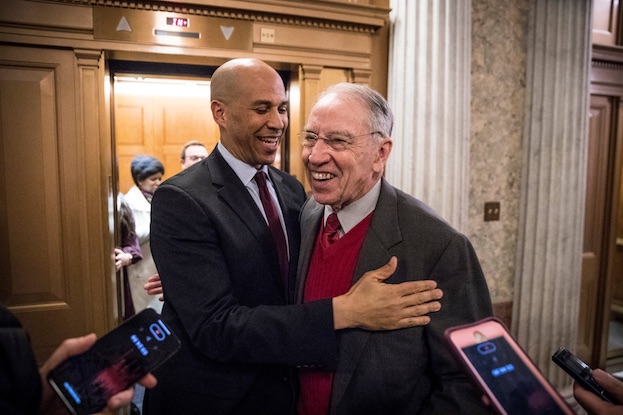Senate Passes Sweeping Criminal Justice Reform [refinement] Bill but Doesn’t End System’s Racial Bias & Goal of Placing Non-Whites in Greater Confinement
/Dr. Blynd defines Reform as ‘the appearance of change sans the change. Reform is always in the service of the status quo and the politician: it serves the privilege of the past not the promise of the future. Reform is the first stage in the three “R”’s in hue-man evolution; the other two being revolution and rebellion.’
From [HERE] The US Senate approved the First Step Act Tuesday with an overwhelming bipartisan majority vote 87 to 12, marking a substantial overhaul of prison and sentencing laws aimed at reducing recidivism and prison populations.
The bill expands in-prison and post-release employment programming, includes components related to alternatives to prison for low-risk prisoners such as home confinement, prohibits restraints on pregnant prisoners, and mandates evidence-based treatment for opioid and heroin abuse, among others.
The bill revises the Controlled Substances Act’s harsh drug penalties, including a lowering of the “three strikes” rule for drug felons that had sent them to life in prison, now down to 25 years, and it changes the two or more felonies within the rule from any “felony drug offense” to “a serious drug felony or serious violent felony,” defined in the text of the bill.
According to the Congressional Budget Office, the First Step Act would reduce collective federal prison sentences by 53,000 years.
The Act is expected to pass in the House this week, and President Donald Trump said he would sign the bill.
Bill Co-sponsor Senator Cory Booker (D-NJ) said in a press release:
But for the first time in a long time, with the passage of this bill into law, our country will make a meaningful break from the decades of failed policies that led to mass incarceration, which has cost taxpayers billions of dollars, drained our economy, compromised public safety, hurt our children, and disproportionately harmed communities of color while devaluing the very idea of justice in America.
The Sentencing Project stated;
“While many assume that broad criminal justice reforms would automatically reduce racial disparities that have become so pervasive in the justice system, data tell us this simply is not the case.
A new Urban Institute online tool, the Prison Population Forecaster, allows users to see how different approaches to state criminal justice reform would affect the number of people in prison. In every state we looked at, broad cuts to the number of people in prison — both overall and within individual offense categories — do little to reduce the share of the prison population made up of people of color.
New Jersey, for example, is often heralded as one of the most successful examples of reversing mass incarceration, passing justice reforms that led to a 26 percent decline in the state prison population between 1999 and 2012. However, the state did not target racial disparities in incarceration, and a 2016 Sentencing Project analysis found that black people in New Jersey were still more than 12 times as likely to be imprisoned as white people — the highest disparity of any state in the nation.
The reality is that implicit bias and structural racism ensnare people of color — particularly black, Latino and Native American people — in the justice system at astronomical levels, and the evidence is clear that people with identical criminal histories who have committed the same crimes are nonetheless treated differently because of the color of their skin.
For example, research shows that black people are more likely to be stopped, arrested and detained before trial; not have opportunities for reduced charges in plea deals; receive harsher penalties; and serve longer terms in prison than white people in the same situations.
For this reason, racial disparity is prevalent throughout the justice system and grows at every stage, from policing, to arrest and pretrial detention, to trials, sentencing and post-release opportunity.
Not only does this have a devastating impact on communities of color, it also undermines public safety by eroding their confidence in law enforcement. What’s more, it wastes criminal justice resources that could be used for prevention, treatment and services.
The bottom line is that efforts to undo the harmful legacy of mass incarceration must go hand in hand with explicit and intentional racial justice strategies.
Focus on correcting policies known to unfairly affect people of color.
State and local governments around the country are developing innovative ways to address racial disparity in the criminal justice system. At the local level, cities and towns can reform law enforcement practices to reduce concentrated overpolicing and prioritize promising community approaches instead. They can also reject unfair policies such as pretrial money bail.
State lawmakers can examine and reform policies that seem neutral but that can result in disparate outcomes, such as risk-assessment tools, discriminatory gang sentencing enhancements or geography-based school zone drug penalties.
Policymakers can also build checks and balances into the legislative process, such as requiring racial impact statements before any new criminal justice law or regulation is passed to evaluate the potential for unfair outcomes.
The private sector, too, has a role to play with ensuring that all returning citizens have access to the employment and housing they need to succeed.
As Michelle Alexander, author of the book “The New Jim Crow: Mass Incarceration in the Age of Colorblindness,” and many others have pointed out, the U.S. criminal justice system is deeply rooted in racism and inequality.
Coming to terms with this past requires policymakers, advocates and voters to commit to undoing the harm that has been done and moving forward on a better, fairer path.”






























































































































































































































































































